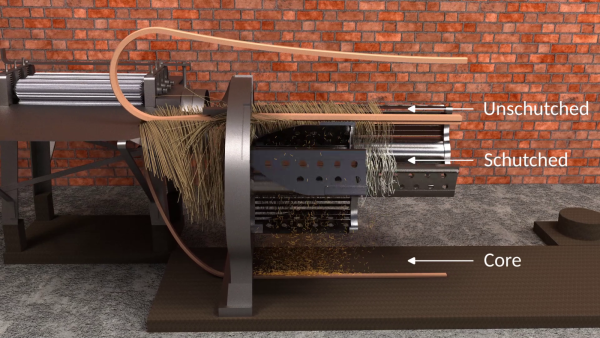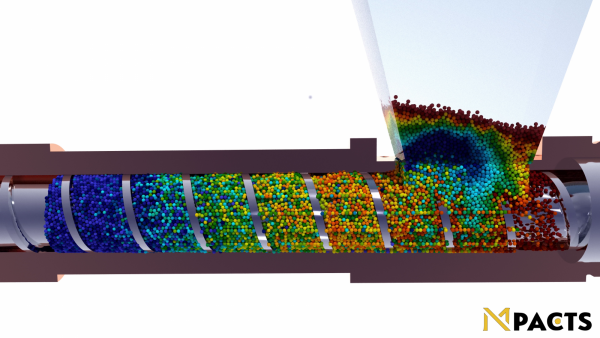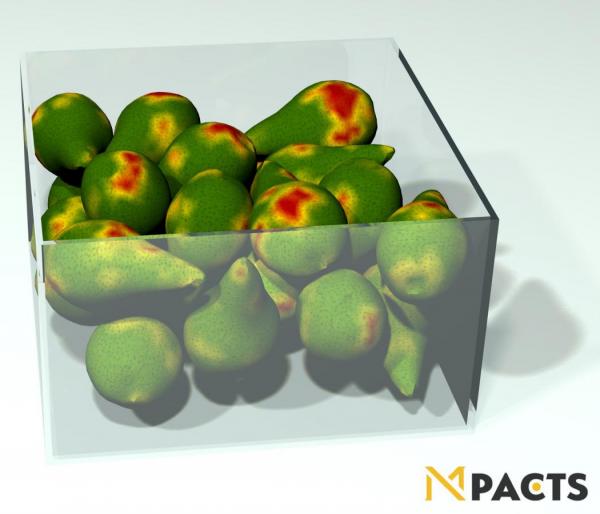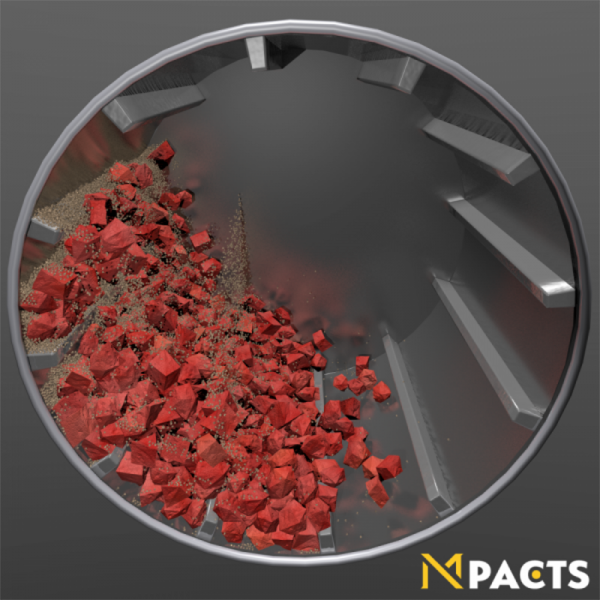Flax Scutching machine

Flax is a commonly used fiber in the clothing industry, and has been for several centuries. To go from crop to fiber, the flax is first harvested. In a next step the flax is retted, a biological process similar to fermentation that makes the fibers in the flax more flexible. Finally, the core material in the flax stem needs to be removed to retain only the soft fiber. Traditionally this was done by hitting the fibers in a labourous and difficult to learn manual process.
The boom of the flax industry in Flanders in the early 20th century combined with the industrial revolution lead to the development of machines to automate the scutching process. In the above video the Scutching machine of the Texture museum was simulated to illustrate its inner workings. In this simulation several of Mpacts features are used such as the decreasing stiffness from unscutched to scutched flax, the break-up of the flax stem into core and fiber material, and the air interaction with the fan.
Transportation and heat transfer
Plastics extruder
Raw plastic pellets are fed into the extruder. While the extruder transports the material, the plastics are gradually melted by the friction energy generated by turning screws and by heaters arranged along the barrel.
By quantifying the throughput of material and the heat added from mechanical friction, the proces can be optimized. It is important that the heat is equally distributed over the plastic pellets. This is also analysed in the simulation.

Mixing efficiency

Ribbon mixer
The purpose is to mix the particles as quickly and homogeneous as possible. Mixing is equivalent to decreasing the order of the particles in the blender. At the start, the system is completely sorted in the length and width direction. When the mixer starts rotating, you can see the order decreasing in the right-hand figure.
With these results, it is possible to experiment with different ribbon mixer designs and settings, without the need to build expensive prototypes.
Fruit and crop handling
Fruit bruise reduction
Bruise damage in fruits and vegetables is an important source of economic losses and food waste. Especially soft fruits are very susceptible to bruises. Simulations using Mpacts with virtual fruit and vegetables are a powerful and cost-effective approach for improving fruit and crop handling.
For example, they can help guide the design of an optimal picking gripper for different fruit shapes. Simulations can also provide insight in the critical frequencies and amplitudes that should be avoided during transport. Using that knowledge, transport vehicles can be adjusted or packaging techniques and materials can be imporoved in order to obtain better damping of damaging vibrations.
http://dx.doi.org/10.1016/j.postharvbio.2016.06.003
Discrete Element Method simulations can help design sorting lines, and not only to help prevent bruise damage. Simulations of the fruit singulator in sorting lines can be used to examine at which rotational speed or with what type of diabolo a good singulation and fruit alignment can be realized.

Process design

Milling operation
This figures shows a milling simulation, where arbitrarily shaped particles are placed in a rotating drum. Typically, an abrasive action is desired on the particles, induced by the rotational motion of the mill.
Simulations can help answer a range of questions during the design phase of these milling machines. DEM simulations can predict the distribution of impact energies. With this information available, the mill can be either optimised to be as 'aggressive' as possible, or if only partial destruction is desired, e.g. when separating materials rather than milling it, an optimal impact distribution may be computed.
Another very common problem is process upscaling. How do the forces scale when a working-lab scale equipment is scaled up to an industrial scale? What are the new optimal setpoints for the rotational velocity, and how do we have to modify the industrial design to mimick the lab scale conditions as closely as possible?